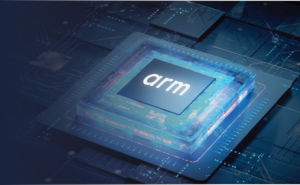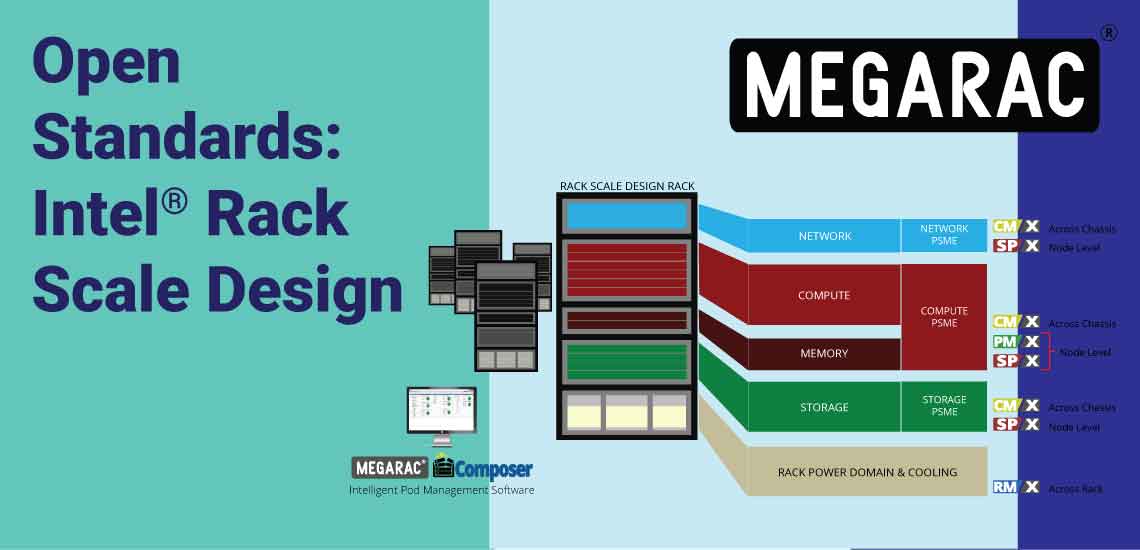As we continue our exploration of open standards in server design and management, today we will take a closer look at the Intel® Rack Scale Design standard, devised and promoted by its namesake organization, Intel Corporation. As a key partner and collaborator with Intel for much of our corporate history, the decision to incorporate this powerful and flexible hardware management API into a number of its MegaRAC® remote management products soon after its introduction was an easy one.
WHAT IS RACK SCALE DESIGN?
Intel® Rack Scale Design is an open framework that defines the standards for composing logical servers from disaggregated pools of storage, network and compute resources. Intel® Rack Scale Design Software APIs simplify resource management and provide the ability to dynamically compose resources based on workload-specific demands.
Our MegaRAC solutions for Rack Scale Design are focused on enabling high efficiency for building, managing and improving cloud infrastructure in a software-defined data center. These solutions are fully compliant with Intel Rack Scale Design and DMTF Redfish™ standards, including MegaRAC Pooled System Management Engine (PSME) firmware solutions and the MegaRAC Composer® Pod Management Software.
WHY RACK SCALE DESIGN?
The Rack Scale Design (RSD) standard offers unique and important benefits to both manufacturers and end-users, including increased performance through pooled resources (network, compute, and storage), hyper-scale agility thanks to a flexible, modular architecture and improved data center operations with analytics-based telemetry.
THE ADVANTAGES OF RACK SCALE DESIGN SOLUTIONS
Fully Integrated
Manufacturers can integrate the Rack Scale functionality within the BMC or other Management controller firmware on participating RSD hardware units. This includes compute and storage nodes as well as switches. Now OEMs and ODMs can build Rack Scale solutions using the existing BMC development skills and infrastructure they already have. Being integrated on the BMC firmware, it ensures a quick path to production without calling for any alteration in the manufacturing process.
Out-of-the-Box
All Rack Scale intelligence is pre-built and comes out of the server hardware that the OEM or OEM produces, for the ability to create custom proprietary solutions on the hardware they contribute and control.
Out-of-Band
RSD solutions are one hundred percent out-of-band, eliminating the need to run required RSD software components on dedicated server nodes. In turn, this frees the server node for doing more compute jobs and does not tie up processing power strictly for running RSD tasks.
Fail-Safe Architecture
RSD solutions are distributed BMC-based solutions on server nodes in a rack as opposed to running vital components on a dedicated server node in a rack. Dedicated server-based solutions impose a “single point of failure” threat, meaning that in the event of the server crashing, the entire rack loses its Rack Scale capability for all nodes. This inherently demands a failover deployment practice for the dedicated hardware running RSD software. It also increases CAPEX and incurs a loss of productivity by having to occupy two or more compute nodes which are taken away from the main compute pool.
Lower TCO in the Datacenter?
Being integrated at the existing onboard firmware and being part of the Life Cycle Management in place of a data center, such uniquely positioned RSD solutions lowers the TCO significantly. This means that there is no need for maintaining servers running RSD software, employing failover strategies for these servers running RSD management software and paying for extra power drawn by these servers, which is just a few of the key TCO-sensitive items.
Rack Design Flexibility
Now OEMs and ODMs can build racks with flexible server (compute, storage and switch) designs that can comply with all industry standards without asking for any hardware change. Server hardware with manageability designed with the RSD standard can also be immediately compliant with major industry standards like the Open Compute Project (OCP), Scorpio from the Open Data Center Committee (ODCC) and even an OEM-proprietary rack solution.
RACK SCALE DESIGN SOLUTIONS FROM AMERICAN MEGATRENDS
AMI has built a unique value proposition for OEM and ODM through its RSD solution offerings to leverage the strengths and advantages of this standard. The MegaRAC RSD product line from AMI enables OEMs/ODMs to build a fully integrated, out-of-the-box, out-of-band, fail-safe Rack Scale solution that truly meets the needs of the industry. Through its industry-leading MegaRAC product line, AMI is positioned to offer best-in-class, robust, productized RSD solutions together with a solid support model that has been trusted by OEM and ODM customers for decades.
MegaRAC PSME Firmware Solutions
MegaRAC PSME firmware solutions are hardened, production-worthy and tightly integrated to function with the MegaRAC manageability firmware stack used by nearly every OEM – and within most hyper-scale data centers. These solutions can be deployed in a single image to the popular (BMC) service processors, but are also configurable to run stand-alone on x86 or other architectures as well as with custom OEM manageability firmware stacks. MegaRAC PSME solutions can not only run on compute nodes integrated with the server BMC, but also on Chassis or Rack Management Modules or they can run as a Container under the Pod Manager. These solutions all work under a Redfish Framework, making it easy to add extensions, such as Fabric Management.
MegaRAC Composer Pod Management Software
MegaRAC Composer also allows for the composition of physical resources based on templates, which can then be stored in the software and reused as a time-saving feature. In addition, MegaRAC Composer gives users the ability to power on, force off, and gracefully shutdown composed nodes
What are your thoughts on the future of open standards for server and data center design and management? Do you have any suggestions for any particular open standards you would like us to explore further in upcoming posts on this blog? Drop us a line via social media or our Contact Us form and let us know and as always, thanks for reading!






